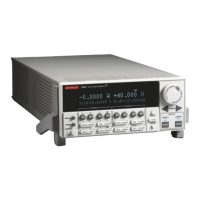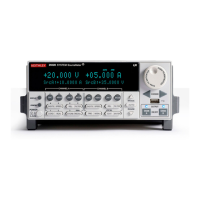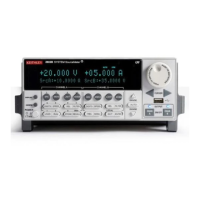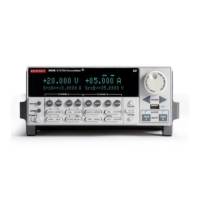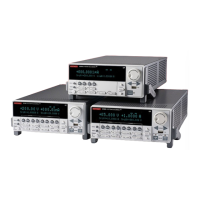3-11
SECTION 3
Bipolar Transistor Tests
3.6.2 Example Program 8: I
CEO
Test
Use Program 8 to run I
CEO
tests on bipolar transistors. Follow
these steps to run the program:
With the power off, connect a dual-channel System Source-1.
Meter instrument to the computer’s IEEE-488 interface.
Connect the test fixture to both units using appropriate 2.
c a b l e s .
Turn on the instrument and allow the unit to warm up for two 3.
hours for rated accuracy.
Turn on the computer and start Test Script Builder (TSB). Once 4.
the program has started, open a session by connecting to the
instrument. For details on how to use TSB, see the Series 2600
Reference Manual.
You can simply copy and paste the code from Appendix A in 5.
this guide into the TSB script editing window (Program 8),
manually enter the code from the appendix, or import the TSP
file ‘Iceo.tsp’ after downloading it to your PC.
If your computer is currently connected to the Internet, you
can click on this link to begin downloading: http://www.
keithley.com/data?asset=50917.
Install a small-signal NPN silicon transistor such as a 2N3904 6.
in the appropriate transistor socket of the test fixture.
Now, we must send the code to the instrument. The simplest 7.
method is to right-click in the open script window of TSB,
and select ‘Run as TSP file’. This will compile the code and
place it in the volatile run-time memory of the instrument.
To store the program in non-volatile memory, see the “TSP
Programming Fundamentals” section of the Series 2600 Refer-
ence Manual.
Once the code has been placed in the instrument run-time 8.
memory, we can run it at any time simply by calling the func-
tion ‘
Iceo()
’. This can be done by typing the text ‘
Iceo()
’
after the active prompt in the Instrument Console line
of TSB.
In the program ‘9. Iceo.tsp’, the function
Iceo(vstart,
vstop, vsteps)
is created.
vstart represents the initial voltage value in the V•
CE
sweep
vstop represents the final voltage value in the V•
CE
sweep
vsteps represents the number of steps in the sweep•
If these values are left blank, the function will use the default
values given to the variables, but you can specify each variable
value by simply sending a number that is in-range in the func-
tion call. As an example, if you wanted to have the start voltage
be 1V, the stop value be 11V, and the number of steps be 20,
you would send
Iceo(1, 11, 20
) to the instrument.
The sources will be zeroed and then enabled. The program 10.
will execute a voltage sweep on the collector-emitter and
measure the collector-emitter current (I
CEO
) at each point.
Once the measurements have completed, the data (V11.
CE
and I
CE
)
will be presented in the Instrument Console window of TSB.
3.6.3 Typical Program 8 Results
Figure 3-8 shows an example I
CEO
vs. V
CEO
plot generated by
Program 8. The device used for this example was a 2N3904 NPN
transistor.
3.6.4 Program 8 Description
The instrument is returned to default conditions. SMUA, which
sweeps V
CEO
and measures I
CEO
, is set up as follows:
Source V•
Local sense•
10mA compliance, autorange measure•
1 NPLC Line cycle integration•

